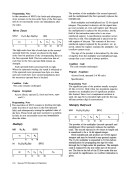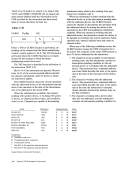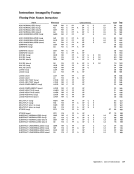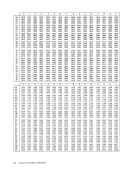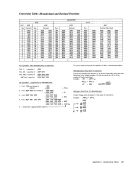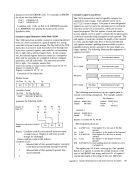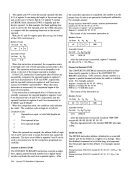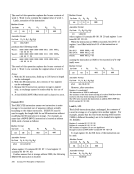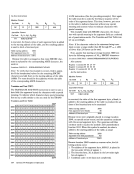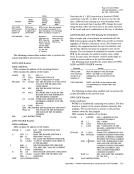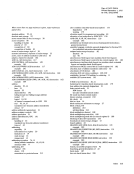Input / Output Device Addressing
AnI/O device and the associated access path are
designated by anI/O address. The I/O address is a
16-bitbinary number and consists of two parts: a
channel address in the eight high-order bit positions
and adevice address in the eight low-order bit posi
tions.
The channel-address field provides for identifying
up to 256 channels. Channel0 is a byte-multiplexer channel; channels numbered 1-255 may be either
multiplexer or selector channels.
The number and type of channels available, as
well as their address assignment, depend on the sys
tem model and the particular installation.
The device address identifies the particu1arI/O device and control unit on the designated channel.
The address identifies, for example, a particular
magnetic tape drive, disk-access mechanism, or
transmission line. Any number in the range0-255 can be used as a device address, providing facilities
for addressing up to 256 devices per channel. An
exception is some byte-multiplexer channels thatprovide fewer than the maximum configuration of
subchannels and hence eliminate the corresponding
unassignable device addresses.
Devices that do not share a control unit with oth
erdevices may be assigned any device address in the
range0-255, provided the address is not recognized
by any other control unit. Logically, such devices are
not distinguishable from their control unit, and both
are identified by the same address.
Devices sharing a control unit (for example, mag
netic tape drives or disk-access mechanisms) are
assigned addresses within sets of contiguous num
bers. The size of such a set is equal to the maximum
number of devices that can share the control unit, or
16, whichever is smaller. Furthermore, such a set
starts with an address in which the number of low
order zeros is at least equal to the number of bit
positions required for specifying the set size. The
high-order bit positions of an address within such aset identify the control unit, and the low-order bit
positions designate the device on the control unit.
Control units designed to accommodate more than
16 devices may be assigned nonsequential sets of ad
dresses, each set consisting of 16, or the number re
quired to bring the total number of assigned addressesequal to the maximum number of devices attachable
to thecontrol unit, whichever is smaller. The address ing facilities are added in increments of a set so that
the number of device addresses assigned to a control
unit does not exceed the number of devices attached
by more than 15.192 System/370 Principles of Operation
The control unit does not respond to any address
outside its assigned set or sets. For example, if a
control unit is designed to control devices having
only bits0000-1001 in the low-order positions of
the device address, it does not recognize addresses
containing1010-1111 in these bit positions. On the
other hand, a control unit responds to all addresses
in the assigned set, regardless of whether the device
associated with the address is installed. For example,
the IBM3830 Storage Control Model 2, with four
disk units installed, responds to all of the 16 address
es within the set assigned to it. If no control unit
responds to an address, theI/O device appears not
operational. If a control unit responds to an address
for which no device is installed, the absent device
appears in the not-ready state.
Input/ output devices accessible through more
than one channel have a distinct address for each
path of communications. This address identifies the
channel and the control unit. For sets of devices
connected to two or more control units, the portion
of the address identifying the device on the control
unit is fixed, and does not depend on the path of
communications.
Except for the rules described, the assignment of
channel and device addresses is arbitrary. The as
signment is made at the time of installation, and the
addresses normally remain fixed thereafter.
States of the Input/Output System
The state of theI/O system identified by an I/O address depends on the collective state of the chan
nel, subchannel, andI/O device. Each of these com
ponents of theI/O system can have up to four
states, as far as the response to anI/O instruction is
concerned. These states are listed in the following
table. The name of the state is followed by its abbre
viation and a brief definition.
A portion of the110 system that is available,
interruption-pending, or working is called"operational." A portion of the I/O system that is
interruption-pending, working, or not-operational is
called"not available."
In the case of a multiplexer channel, the channel
and subchannel are easily distinguishable and, if the
channel is operational, any combination of channel
and subchannel states is possible. Since the selector
channel can have only one subchannel, the channel
and subchannel are functionally coupled, and certain
states of the channel are related to those of the sub
channel. In particular, the working state can occur
only concurrently in both the channel and subchan
nel and, whenever an interruption condition is pend-
An
designated by an
16-bit
channel address in the eight high-order bit positions
and a
tions.
The channel-address field provides for identifying
up to 256 channels. Channel
multiplexer or selector channels.
The number and type of channels available, as
well as their address assignment, depend on the sys
tem model and the particular installation.
The device address identifies the particu1ar
The address identifies, for example, a particular
magnetic tape drive, disk-access mechanism, or
transmission line. Any number in the range
for addressing up to 256 devices per channel. An
exception is some byte-multiplexer channels that
subchannels and hence eliminate the corresponding
unassignable device addresses.
Devices that do not share a control unit with oth
er
range
by any other control unit. Logically, such devices are
not distinguishable from their control unit, and both
are identified by the same address.
Devices sharing a control unit (for example, mag
netic tape drives or disk-access mechanisms) are
assigned addresses within sets of contiguous num
bers. The size of such a set is equal to the maximum
number of devices that can share the control unit, or
16, whichever is smaller. Furthermore, such a set
starts with an address in which the number of low
order zeros is at least equal to the number of bit
positions required for specifying the set size. The
high-order bit positions of an address within such a
positions designate the device on the control unit.
Control units designed to accommodate more than
16 devices may be assigned nonsequential sets of ad
dresses, each set consisting of 16, or the number re
quired to bring the total number of assigned addresses
to the
the number of device addresses assigned to a control
unit does not exceed the number of devices attached
by more than 15.
The control unit does not respond to any address
outside its assigned set or sets. For example, if a
control unit is designed to control devices having
only bits
the device address, it does not recognize addresses
containing
other hand, a control unit responds to all addresses
in the assigned set, regardless of whether the device
associated with the address is installed. For example,
the IBM
disk units installed, responds to all of the 16 address
es within the set assigned to it. If no control unit
responds to an address, the
operational. If a control unit responds to an address
for which no device is installed, the absent device
appears in the not-ready state.
Input/ output devices accessible through more
than one channel have a distinct address for each
path of communications. This address identifies the
channel and the control unit. For sets of devices
connected to two or more control units, the portion
of the address identifying the device on the control
unit is fixed, and does not depend on the path of
communications.
Except for the rules described, the assignment of
channel and device addresses is arbitrary. The as
signment is made at the time of installation, and the
addresses normally remain fixed thereafter.
States of the Input/Output System
The state of the
nel, subchannel, and
ponents of the
states, as far as the response to an
concerned. These states are listed in the following
table. The name of the state is followed by its abbre
viation and a brief definition.
A portion of the
interruption-pending, or working is called
interruption-pending, working, or not-operational is
called
In the case of a multiplexer channel, the channel
and subchannel are easily distinguishable and, if the
channel is operational, any combination of channel
and subchannel states is possible. Since the selector
channel can have only one subchannel, the channel
and subchannel are functionally coupled, and certain
states of the channel are related to those of the sub
channel. In particular, the working state can occur
only concurrently in both the channel and subchan
nel and, whenever an interruption condition is pend-









































































































































